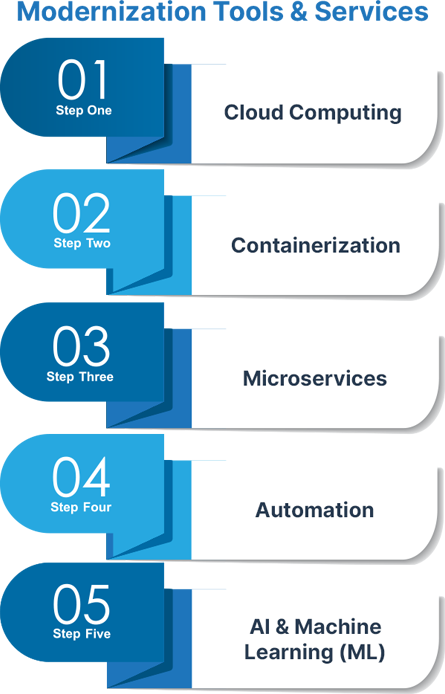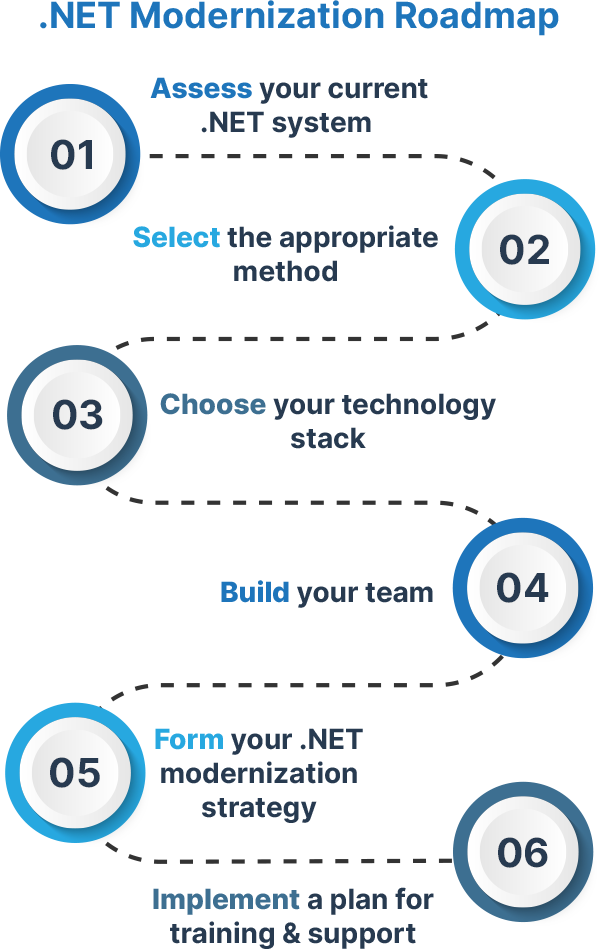What is Modernization?
Introduction
Introduction
But legacy system .NET applications are not without their challenges. Older applications may struggle with performance, are vulnerable to security threats, and may not work well with more modern applications. But good news; the .NET framework still carries significant potential in its modernization capabilities, and can update your business processes to keep up with modern demands well into the future.
If you rely on the .NET framework, you may want to consider how .NET modernization can fit into your current business goals and unique vision for the future. This guide will provide expert insights into legacy .NET modernization, and how Programmers.io can set you up for future success.
What is Modernization?
What is Modernization?
The phrase “legacy system modernization” refers to the process of transitioning from traditional software functionalities, to processes that are more aligned with an up-to-date IT landscape. This term encompasses a diverse range of solutions and methods for updating your business practices.
Modernizing your .NET framework can include:
- Upgrading your code to more modern .NET versioning
- Migrating to a different platform (cloud or web-based)
- Implementing DevOps practices (e.g. microservices, automation, CI/CD)
- Utilizing APIs for enhanced communication between applications
- Transitioning from licensed products to open source
- Redesigning or even starting your code completely from scratch
Modernization of your .NET framework can also include improving the look and feel of your existing applications. Older applications may require a design revamp, which includes a modern look as well as intuitive, user-friendly controls. It may also be imperative to upgrade your applications so that they can run on both desktop and mobile devices. Internally, these solutions are well-received by employees and lead to increased productivity and engagement. Externally, you are likely to see a significant increase in customer satisfaction and retention.
Modernization Tools and Services
Modernization Tools and Services
Companies have a variety of contemporary services to choose from when modernizing their .NET-based applications. Each requires their own set of expertise and can provide the following benefits to new and existing features, workflows, and performance:

Cloud Computing (using internet-based services) is used for enhanced speed, flexibility, and scalability, and can be a more cost-effective option depending on your existing infrastructure.
Cross-platform services allow your code to operate across multiple operating systems, device types, or environments with minimal rewriting and effort. This ensures that your application runs consistently across environments and has a standard look and feel.
Microservices break down large programs into manageable pieces that can be worked on and deployed independently. This allows for increased agility, fault isolation, and speed to market within your program.
Automation is a tool that can be applied to a wide array of functions. Automation is used to greatly reduce manual effort and can also help optimize application deployment, management, and diagnostics.
AI, Machine Learning (ML), and other intelligent services allow companies to glean in-depth insights from their data as well as enhance consumer personalization.
As companies grow beyond their system capabilities or want to incorporate newer technologies into their product or service lifecycle, it becomes imperative to consider if your technology is still meet for the modern digital age. Let’s dive into common issues and signs that it may be time to upgrade your .NET framework.
Why Modernize?
Why Modernize?
With the right IT team or business partner, unlocking your .NET framework’s potential is crucial for staying competitive. As your systems age, new challenges may arise that affect business processes and impede future development.
Common issues include:
- Cybersecurity: Legacy systems may contain significant vulnerabilities that are susceptible to cyber-attacks.
- Workflow Inefficiencies: Many outdated .NET systems still rely on manual workflows that may take more time and have a higher potential for errors.
- Expertise & Support: The talent pool for legacy systems is shrinking by the day, which can lead to costly maintenance, downtime, and lack of available support.
- Customer Retention: With rising consumer expectations, outdated functionalities may result in missed opportunities or cause existing customers to look elsewhere.
Successful .NET modernization should provide impactful results in both the short and long term. Depending on your strategy, you should consider the KPIs for each of your modernization initiatives. This can include savings from decreased downtime and on-premises cost (for cloud solutions), as well as enhanced efficiency, compliance, and speed to market, to name a few. Cost savings is a prominent driver of .NET modernization efforts, and can quickly add up to produce significant value for your organization.
Your system should add value to your organization, align with company goals, and allow for future growth and innovation. Modernization aims to solve the above issues and comes with other benefits such as improved performance, customer experience, energy efficiency, and more.
How to Modernize – A Concise Roadmap
How to Modernize – A Concise Roadmap
Getting started on modernizing your .NET framework is no simple task. Here are a few simple steps with key considerations to help you get started.

-
Assess Your Current .NET System
The first step to modernizing your .NET applications is to work with your IT team to conduct a thorough assessment of your system’s current capabilities. Are there any pain points, inefficiencies, or other areas that are hindering operations? Is your system able to handle growing business needs? You’ll need to audit:
- Current hardware and software in use at your organization
- Any integration problems you’re experiencing
- Any existing compatibility issues between apps
- All outdated features that simply aren’t working as expected
Compare the current state of your technology with your company goals and vision to decide on the overarching goal of your project.
-
Select the Appropriate Method
Once you’ve identified the areas you’d like to improve, choose a modernization method that makes the most sense for your system, budget, and needs. Here are some common ways to modernize your .NET framework:
Rehosting is moving your current .NET application as-is to the cloud without any major modifications. This is known as the “lift-and-shift” method and is the easiest way to migrate to the cloud.
Refactoring is the process of improving your application’s code without changing its external behavior. This reduces the complexity of your code, making it much easier to update and maintain going forward.
Replatforming is another method of cloud migration that involves optimizing your current applications for cloud performance. This is known as the “lift, tinker and shift” approach.
Rearchitecting involves thoroughly redesigning your software architecture to allow for new capabilities and functionalities.
UI Modernization improves the frontend appearance of your application without changing the core logic. This approach is meant to boost metrics such as user engagement, satisfaction, and loyalty, among others.
Your chosen method should meet your project needs and offer a quick and significant ROI. Consider if a prebuilt SaaS market solution would work, or if you need to pursue a more customized solution.
-
Choose Your Technology Stack
Choosing a technology stack is a crucial part in the modernization process. Your chosen tech stack will influence how your software development lifecycle (SDLC) operates, as well as determine the software’s features, capabilities, platform and device compatibility, user-friendliness, and scalability. We recommend consulting with an experienced and dedicated backend developer to decide on the right technologies for your project goals.
-
Build Your Team
Next, you’ll be able to begin building your team based off of a clear modernization goal and chosen technology stack. Your team should include department heads, operations leaders, and dedicated .NET developers that have your desired expertise. Having the proper leadership and oversight over your project is a crucial step for ensuring a smooth modernization, as it outlines clear responsibilities and makes sure that all key decision-makers are on the same page. Additionally, following clear internal procedures and coding standards will keep your application clean and maintainable.
-
Form Your .NET Modernization Strategy
For any modernization or significant IT project, the planning is just as important as the implementation. Simplicity is key. Here are a few considerations to keep in mind:
- Begin by establishing clear milestones and success metrics for a transparent and unified goal.
- Work with your IT team to set a reasonable timeline based on project size and complexity.
- Plan for risk and have a process in place for managing changes as they arise.
- Implement strong testing practices to ensure your changes are reliable.
- Keep to robust security practices every step of the way to mitigate risk and ensure compliance.
One of the most common reasons modernization projects fail is the lack of a clear vision and strategy. Beginning with a comprehensive plan avoids unnecessary confusion and scope creep, and is critical to successful .NET modernization.
-
Training and Support
The final step in modernizing your legacy .NET application is to have plans in place for training and support. New users (including employees and consumers) may need to adapt to the new system and learn how to leverage its new functionalities. Make sure to allocate time for training and consider using a Digital Adoption Platform (DAP) for guided tours and in-app help.
Additionally, you’ll need to have a plan for supporting and maintaining your new system. Implementations need to be monitored by people that have specific expertise and insight into your network and can fix issues as they arise. Regular updates ensure that your upgraded .NET system stays relevant and performs well.
How Programmers.io Can Help
How Programmers.io Can Help
One of the biggest hurdles companies face in any modernization project is a lack of expertise or other personnel-related challenges. Specialized expertise and knowledge of best practices are not luxuries, but rather critical assets when dealing with important projects.
Working with an external team not only alleviates the strain on your internal team but ensures that you are working with personnel that are experienced at .NET projects and customizations. External teams further provide the benefit of end-to-end consulting, which significantly mitigates risk and contributes to a timely ROI.
Working with Programmers.io provides access to hundreds of skilled and reliable .NET talent. We work with clients as a true partner, and provide consultations, support, and an industry-unique Happiness Guarantee to ensure project success.
Contact us today for any questions or to set up a free consultation.
Industry Use Cases:
Case Study: PIO Modernizes Applications and Processes for a Timely Resolution – Programmers.io
Case Study: Multiple Integrations for Global E-Commerce | Logistics & Supply Chain Tech Case Study
Blog Article: Artificial Intelligence and Machine Learning with .NET- Programmers.io
Blog Article: The Future Of .NET Development: A Comprehensive Guide
Our Services: Hire .Net Developers – ASP Dot Net Development Company & Services in USA
